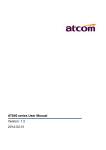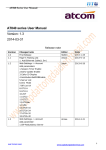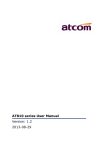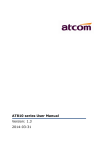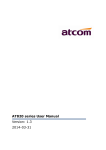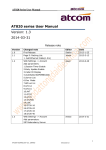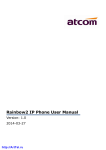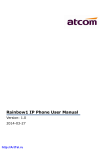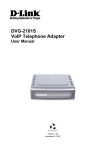Download ATCOM AT800 Series User manual
Transcript
AT800 series User Manual Version: 1.2 2013-08-29 AT800 Series User Manual Release note Version Changed note Editor Date 1.0 First Release Stefen 2013-1-25 1.1 Page 9: Packing List 1. Add Ethernet Cable(1.5m) Jessie 2013-5-13 1.2 Web Settings -> Account Add parameters description: 1.Session Timer Enable 2.Early Update Enable 3.Caller ID Display 4.AutoSubscribeMWBEnable 5.Server List 6.Dns Mode 7.Blf List Uri 8.G711A 9.G711U 10.AVT 11.G722 12.G723 13.G729ab 14.iLBC 15.G726-16 16.G726-24 17.G726-32 18.G726-40 Jason 2013-8-26 ATCOM TECHNOLOGY CO., LIMITED www.atcom.cn AT800 Series User Manual content Contact ATCOM ............................................................................................................................................. 6 AT800 Series Overview .................................................................................................................................. 7 Interfaces ....................................................................................................................................................... 7 Hardware ....................................................................................................................................................... 8 Software ........................................................................................................................................................ 8 Network ......................................................................................................................................................... 8 Management and Maintenance .................................................................................................................... 9 Protocol ......................................................................................................................................................... 9 Compliant Standard ....................................................................................................................................... 9 Operating Requirement ............................................................................................................................... 10 Packing List .................................................................................................................................................. 10 Getting started............................................................................................................................................. 10 Keypad ................................................................................................................................................. 11 Indicator status .................................................................................................................................... 13 Installation ........................................................................................................................................... 13 Power on...................................................................................................................................... 13 DC Power ............................................................................................................................. 14 PoE ....................................................................................................................................... 14 Headset........................................................................................................................................ 15 Sip Register .................................................................................................................................. 15 Basic Phone Functions ................................................................................................................................. 16 Place or Answer a call .......................................................................................................................... 16 Volume and Mute ................................................................................................................................ 17 Volume......................................................................................................................................... 17 Mute ............................................................................................................................................ 17 Hold ..................................................................................................................................................... 17 Resume a call ....................................................................................................................................... 17 Ending a call ......................................................................................................................................... 17 Transfer ................................................................................................................................................ 18 Attended transfer ........................................................................................................................ 18 Blind transfer ............................................................................................................................... 18 3-Way conference Call ......................................................................................................................... 18 Redial ................................................................................................................................................... 19 Missed calls.......................................................................................................................................... 19 Last Call Return .................................................................................................................................... 19 Do Not Disturb ..................................................................................................................................... 19 Call History........................................................................................................................................... 20 Advance Phone Features ............................................................................................................................. 20 Privacy and Security Features .............................................................................................................. 20 Auto Answer ................................................................................................................................ 20 LCD screen ........................................................................................................................................... 21 LCD Contrast ................................................................................................................................ 21 ATCOM TECHNOLOGY CO., LIMITED www.atcom.cn AT800 Series User Manual Backlight ...................................................................................................................................... 21 Ring Tones............................................................................................................................................ 21 Date and Time ..................................................................................................................................... 21 Reboot ................................................................................................................................................. 22 Product Info ......................................................................................................................................... 22 Network ............................................................................................................................................... 22 LAN port ...................................................................................................................................... 22 Web Interface .............................................................................................................................................. 23 System status ....................................................................................................................................... 23 Network ............................................................................................................................................... 24 LAN Port....................................................................................................................................... 24 Advance ....................................................................................................................................... 25 SIP settings........................................................................................................................................... 26 SIP Parameters ............................................................................................................................. 26 SIP Timer Values .......................................................................................................................... 26 RTP Parameters............................................................................................................................ 27 SDP Payload Types ....................................................................................................................... 27 NAT Support Parameters ............................................................................................................. 28 Account Settings .................................................................................................................................. 28 SIP ................................................................................................................................................ 29 Codec Configuration .................................................................................................................... 30 Call feature setting....................................................................................................................... 31 Dial Plan ....................................................................................................................................... 31 Phone setting....................................................................................................................................... 33 Preference ................................................................................................................................... 33 Audio Device ........................................................................................................................ 33 LCD ....................................................................................................................................... 33 Control Timer Values (seconds) ........................................................................................... 34 Date and Time ..................................................................................................................... 34 Feature......................................................................................................................................... 35 Speed dial ............................................................................................................................ 35 Call Forward ......................................................................................................................... 35 Others .................................................................................................................................. 36 Voice ............................................................................................................................................ 36 Echo Cancellation ................................................................................................................ 36 Jitter Buffer .......................................................................................................................... 37 Ring .............................................................................................................................................. 37 Tone ............................................................................................................................................. 38 Programmable key ....................................................................................................................... 39 Update and provision .......................................................................................................................... 39 Manual update ............................................................................................................................ 39 Auto provision ............................................................................................................................. 40 Configuration Profile............................................................................................................ 40 Reset and Reboot ........................................................................................................................ 40 ATCOM TECHNOLOGY CO., LIMITED www.atcom.cn AT800 Series User Manual Phone book.......................................................................................................................................... 41 Call log ................................................................................................................................................. 41 FAQ .............................................................................................................................................................. 42 How to restore to factory settings ....................................................................................................... 42 Upgrading in the safe mode ................................................................................................................ 42 How to make direct IP calls ................................................................................................................. 42 How to connect headset...................................................................................................................... 42 Trouble shooting.......................................................................................................................................... 43 Phone can’t register to the SIP server.................................................................................................. 43 Device can’t obtain IP address ............................................................................................................. 43 Conversation with one way speech ..................................................................................................... 43 ATCOM TECHNOLOGY CO., LIMITED www.atcom.cn AT800 Series User Manual Contact ATCOM The Introduction of ATCOM ATCOM is the leading VoIP hardware manufacturer in global market. We have been keeping innovating with customer’s needs oriented , working with partners to establish a total solution for SMB VoIP with IP phone , IP PBX and Asterisk cards With over 10 years’ experience of R&D , manufacturing and service in network and VoIP filed ; mission of creating the biggest value for IP terminals , we commit ourselves in supplying the competitive IP phone and other terminals for IP PBX , softswitch , IMS , NGN providers and carriers; supplying the competitive total VoIP solution for SMB market. We keep improving the customer’s experience and creating the bigger value with our reliable products. Until now , our VoIP products has been sold to over 60 countries and used by millions of end users. Contact Sales Address Area C, A2F , Block 3 ,Huangguan Technology Park , #21 Tairan 9th Rd, Chegongmiao , Futian District , Shenzhen China Tel + (86) 755-83018618-8888 Fax + (86) 755-83018319 E-mail [email protected] Contact Technical Support Tel E-mail + (86) 755-83018618-8011 [email protected] Website Address: http://www.atcom.cn/ Download Center: http://www.atcom.cn/download.html ATCOM TECHNOLOGY CO., LIMITED www.atcom.cn AT800 Series User Manual AT800 Series Overview AT800D/AT800DP AT800/AT800P Model LCD Screen PoE AT800DP Yes Yes AT800D Yes No AT800P No Yes AT800 No No Interfaces Power input: DC 6~15V, 5W LAN: RJ45 port PC: RJ45 port Headset jack 1 : RJ9 port ATCOM TECHNOLOGY CO., LIMITED www.atcom.cn AT800 Series User Manual Hardware LCD: 128×32 dot matrix FLASH: 8MB SDRAM: 16MB CPU: 262MHz Dual Core LED indicator:Login indicator , MWI, Mute indicator, Call indicator Support HAC(Hearing Aid Compatible) Software SIP 2.0 (RFC3261) 1 SIP account STUN Jitter Buffer,VAD,CNG G.711A/u, G.722, G.723, G.726-16, G.726-24, G.726-32, G.726-40, G.729, iLBC, Lin-16 Codec G.168 compliant 96ms echo cancellation Support SIP domain,SIP authentication(none,basic,MD5),NDS. Support inband , RFC2833 and SIP info DTMF Call Forward, Call transfer, Call hold, 3-way conference, Redial DND(Do Not Disturb), Auto answer, Blacklist, Block Caller ID, Block Anonymous Call Dial rule, IP call Phone book with 100 records, 50 answered records, 50 missed records, 50 dialed records Support HTTP, FTP, TFTP updating the configuration Syslog Support SNTP client WEB access Support different level user management Network LAN: Static IP, DHCP, PPPoE(ADSL) PC: Bridge mode Support NAT Support VLAN(DATA VLAN and VOICE VLAN) Qos support Diffserv ATCOM TECHNOLOGY CO., LIMITED www.atcom.cn AT800 Series User Manual Management and Maintenance Support firmware updating in safe mode Support different level user management Configuration via web , keypad Support system log and call log Auto provision Protocol IEEE 802.3 /802.3 u 10 Base T / 100Base TX PPPoE: Point-to-point protocol over Ethernet DHCP: Dynamic host configuration protocol SIP RFC3261, RFC3262, RFC3263, RFC3264, RFC3265, RFC2543, RFC3489, RFC3842, RFC3515, RFC2976, RFC3428, RFC2327, RFC2782, RFC1889 TCP/IP: Transfer Control Protocol/Internet Protocol RTP: Real-time Transport Protocol RTCP: RTP Control Protocol VAD/CNG DNS: Domain Name Server TFTP: Trivial File Transfer Protocol HTTP: Hypertext Transfer Protocol FTP: File Transfer Protocol STUN: Simple traversal of UDP over Nats SNTP: Simple network time protocol ICMP: Internet Control Message Protocol Compliant Standard CE:EN55024,EN55022 Comply with ROHS in EU Comply with ROHS in China Explanation: ATCOM TECHNOLOGY CO., LIMITED www.atcom.cn AT800 Series User Manual The letter “e” is the first letter of “environment: and “electronic”. The rim is a round with two arrow, stands for recycle. The number 20 stands for the years of environment protection. Please note the years of environment protection is not discarding year nor usage life. Operating Requirement Operation temperature: 0~45°C (32~113°F) Storage temperature: -5~55°C (23~ 131°F) Humidity: 10 to 90% no dew Packing List Model Phone Headset Power adapter Manual CD AT800D 1 Optional 1,Standard accessory 1 AT800DP 1 Optional Optional accessory 1 AT800P 1 Optional Optional accessory 1 AT800 1 Optional 1,Standard accessory 1 Note: Power adapter (Input: AC 100~240V, 50/60Hz; Output: DC 12V ,500mA) ATCOM TECHNOLOGY CO., LIMITED www.atcom.cn AT800 Series User Manual Getting started Keypad (AT800D/AT800DP) ATCOM TECHNOLOGY CO., LIMITED www.atcom.cn AT800 Series User Manual (AT800/AT800P) Description of the keys and Screen: Soft buttons Press to select an feature shown in the soft button features LCD Screen Display screen for the phone: It shows the date, time, phone number, incoming caller’s ID(if available),line/call status, extension numbers and the soft button features. Navigation button 1. Move cursor up and down when pressed in menu reviewing. 2. Adjust output volume when pressed in talking state 3. Adjust ringer volume when pressed in idle state. 1~9,*# For entering numbers, letters or characters Programmable Key Function key can be defined as Speed dial key, CFWD, Hold, Xfer, ConF, DND, Redial, Voicemail. Menu Enter Keypad menu settings Mute button Mute/un-mute mic-phone in talking state Headset button Pick up phone to make outgoing calls or answer incoming calls. MWI Message waiting indicator/ Ringing indicator Login button 1. Press to enter login interface to input SIP account username and password to register to sip server. 2. Press in login-ed state to input SIP account password to logout. ATCOM TECHNOLOGY CO., LIMITED www.atcom.cn AT800 Series User Manual Indicator status 1. Login indicator LED Status Frequency Description Red /Flash 500ms on/500ms off LAN Disconnected Red - SIP Unregistered OFF - SIP Registered LED Status Frequency Description Red - Mute OFF - Unmute LED Status Frequency Description Red/Flash 500ms on/500ms off New message Red/Flash 250ms on/250ms off Call ringing Red - Normal working(AT800/AT800P) OFF - No new message LED Status Frequency Description Red - In a conversation Red/Flash 500ms on/500ms off On-hold OFF - Idle state 2. Mute indicator 3. Voicemail indicator 4. Call indicator When boot up,all indicators will be lighted once. When phone is stand by,all the indicators are off. For AT800/AT800P, WMI indicator will be lighted when the phone is working. When updating firmware, all indicators will be flash in frequence 1s on/ 1s off. Installation Power on There are two options for network and power source connections. The administrator will advise which one to use. DC Power ATCOM TECHNOLOGY CO., LIMITED www.atcom.cn AT800 Series User Manual Power over Ethernet (PoE) DC Power 1. Plug in network cable at LAN port. 2. Plug in the power jack with DC 12V/500mA. 3. The phone will show a loading bar and ATCOM logo, and then come into idle display after boot up absolutely. PoE Power over Ethernet. Using a regular CAT5 cable, the phone can be powered from a PoE (IEEE 802.3af) compliant switch or hub. To connect the PoE: Plug in network cable at LAN port which is connected to a PoE switch. ATCOM TECHNOLOGY CO., LIMITED www.atcom.cn AT800 Series User Manual Headset To connect the headset: Connect the RJ-9 headset to the headset jack on the left side of the phone. The pin sequence of RJ9 port on the phone is like following picture: Sip Register Before using the phone, user have to follow below steps to register it. To register the phone: 1. Viewing the Network Information: Press Menu softkey Enter login password (default: 123) Scroll to [6.Network] and press select softkey To view the network information: Current IP : 172.16.0.110, etc. Current Net mask:255.255.255.0 2. Access the IP Phone administrator web user interface: Launch a web browser on a computer that can reach the phone on the network. Enter the IP address of the phone in web browser address bar. For example: http://172.16.0.110 ATCOM TECHNOLOGY CO., LIMITED www.atcom.cn AT800 Series User Manual 3. Configuring the SIP parameters: Click admin on the right corner of the webpage to login administrator interface Click Account tab Under SIP parameters, make the necessary configuration changes to the fields shown in the following table and click submit: Enable: yes/no Enable/disable the SIP registration User ID: The username, provided by ISP. Password: The password, provided by ISP. SIP Server: The registrar and proxy server (we don’t distinguish between the registrar server and the proxy server right now). SIP Port: The default SIP port is: 5060, user can modify it to fit the SIP server’s port. Transport Type: Optional transport type, can be set as UDP/TCP/TLS After that, click submit button to save the configuration. The phone will be restart automatically to make the changes effect. Warning: If the parameter remember account is set to yes, the account information will be saved automatically, user don’t have to make a manual login after a restart; if it is set to no, user will have to enter the User ID and password manually every time restating the phone. Basic Phone Functions Place or Answer a call Press headset button to place or answer a call If the auto answer parameter is set to yes, the incoming call will be answered automatically. Enter the Redial list menu, use navigation button to scroll down to highlight an history number, and press Dial to complete the call. Use the programmable key to place a call to the pre-configured number. For AT800/AT800P, user can place a call as followings: 1. Press headset button, enter number and # (send key) to dial 2. Press headset button, enter a speed dial number, the pre-configured number will be dialed 3. To hang up the active call, press headset button again. Note: If setting * as the send key, use * instead of #, If send key is set to none, wait for about 10 seconds, the number will be dialed automatically. ATCOM TECHNOLOGY CO., LIMITED www.atcom.cn AT800 Series User Manual Volume and Mute Volume To adjust the output volume in a conversation, press right navigation button to increase the volume, or press left navigation button to decrease the volume. Pressing the right/left navigation button on idle state can adjust the volume of the phone’s ringer. Mute To mute the call in a conversation, press the Mute button, the button lights in red. Press the Mute button again to unmute. Hold To put a call on hold in a conversation, press the hold softkey to hold the call When setting a programmable key to hold function, press the specified key will hold the call. For AT800/AT800P, using programmable key to put a call on hold, refer to Programmable key for more details. Resume a call To resume a held call, press Resume softkey. When setting a programmable key to hold function, pressing the specified key again in hold mode can resume the call. For AT800/AT800P, using programmable hold key can resume the call, refer to Programmable key for details. Ending a call Press headset key to hangup. ATCOM TECHNOLOGY CO., LIMITED www.atcom.cn AT800 Series User Manual Transfer There are two types of call transfer: Attended Talking to the third party before transfer the call. Blind Transfer the call directly without talking to the third party. For AT800/AT800P, use programmable Xfer key to make attended transfer, refer to Programmable key for more details. Attended transfer When in a conversation, press Xfer key to enter attended transfer mode and enter transferred number. Press Dial key to call the third party. Do one of the following: 1. To transfer the call before the third party answers, please press Xfer button directly in Called party ringing state. And when the third party answers, the other two parties can talk to each other. 2. To transfer after the third party answers, please wait for the transferred call is answered and then press Xfer key to transfer the call. After that ,the other two parties can talk to each other. Blind transfer When in a conversation, press Bxfer key to enter blind transfer mode and enter the transferred number. Press Dial key to call the third party. The phone will hang up automatically after dial the third party. And the other two party can talk to each other. 3-Way conference Call To initiate a conference call: Press the Conf softkey button in a conversation to hear a dial tone. Enter the telephone number of the third party and press dial key to send it out. 1. Press the Conf softkey in Called party ringing state. When the third party answers the call, it will enter 3-way conference automatically. 2. After the third party answers the call, pressing Conf key to enter 3-way conference. Press Join key to leave the conference and make the two other parties still in a conversation. Press headset key to hang up the conference, and the two other parties will all hang up. For AT800/AT800P, it can only place a Three-way conference call using the programmable key. Please ATCOM TECHNOLOGY CO., LIMITED www.atcom.cn AT800 Series User Manual refer to Programmable key part for more details. Redial To redial a number: Press Redial softkey and select the desired number. Press the programmable key which is set to Redial function, it will dial out the last call in redial list immediately. Missed calls For AT800D/AT800DP, there will be a prompt display on LCD screen to indicate the missed calls. To view all missed calls: If the LCD screen shows a missed call, press the Missed softkey to view a list of missed calls. If the LCD screen does not show a missed call: 1. Press Menu softkey 2. Scroll to Call history and press select 3. Scroll to Missed calls and press select. a) Press dial to dial the number b) Press edit to edit the number c) Press delete to delete the number Last Call Return For AT800D/AT800DP, to return a missed call: If the LCD screen shows a missed call,press the LCR softkey to return the last missed call. If the LCD screen shows more then one missed call, press the Missed softkey button and select a record then press dial key to return the call. Do Not Disturb Do Not Disturb can reject all the incoming calls. If there is an incoming call, the phone will not ring and only display 1 missed call. When Do Not Disturb is enabled, LCD will display "Do Not Disturb" on AT800D/AT800DP. To set Do Not Disturb, choose one of the following options: Set Do Not Disturb via Web Interface 1. Login to the IP Phone Web Interface 2. Click Phone Setting, then Feature 3. Set Do Not Disturb to yes or no ATCOM TECHNOLOGY CO., LIMITED www.atcom.cn AT800 Series User Manual For AT800/AT800P, 1. Using the programmable key to activate or inactivate Do Not disturb function, refer to Programmable key for more details. 2. Using the web interface, refer to Feature part for more details. Call History To view the Call History Lists: Press menu softkey Scroll to Call History and press select There are three options: 1. Redial List 2. Answered Calls 3. Missed Calls Press select to view the list Choose one of the following options: Press dial to dial the selected number Press delete to delete the selected history Press edit to edit the selected number Press cancel to exit Advance Phone Features Privacy and Security Features Auto Answer The phone will answer the call automatically in headset. To auto answer calls: Press Menu softkey Scroll to Preference and press select Scroll to Auto Answer and press edit Change setting by press Y/N, then OK to save setting, Cancel to cancel setting and exit Press save again. ATCOM TECHNOLOGY CO., LIMITED www.atcom.cn AT800 Series User Manual LCD screen Customize LCD screen contrast and backlight. LCD Contrast To adjust the contrast of the LCD screen: Press the Menu softkey Scroll to LCD Contrast and press select Use the right navigation key to increase and left navigation key to decrease the LCD contrast level. Press save to save the change, cancel to cancel. Backlight To adjust the screen Backlight level: Press Menu softkey Scroll to Back Light and press select Use the right navigation key to increase and left navigation key to decrease the LCD Backlight level. Press save to save the change, cancel to cancel. Ring Tones To change a ring tone: Press Menu softkey Scroll to Ring Tone and press select Press change Scroll through the ring tones and press Play to play the highlighted ring tone. Press select to choose it as incoming call ringtone. Date and Time Set NTP or manual date and time: Press Menu Scroll to Date and Time, and press select 1. Time Mode. press chang to change time mode between NTP and Manual, then press OK to submit change. ATCOM TECHNOLOGY CO., LIMITED www.atcom.cn AT800 Series User Manual 2. 3. Manual Settings. Change day and time manually NTP Settings. Get the date and time information from a NTP Sever. Modify NTP server and Time Zone. 4. Date Format. Change date format between day/month and month/day. 5. Time Format. Change time format between 12hr and 24hr. Press save Reboot Reboot phone: Press menu Scroll to reboot, then press select Press OK to reboot the phone, Cancel to exit without rebooting the phone. Product Info To view information about the Product: Press menu softkey Scroll to Product Info, then press select Review the following information: 1. Product Name: AT800 2. Serial Number: Product Serial Number 3. Software Version: Software version of the product 4. Hardware Version: Hardware Version of the product 5. MAC Address: MAC address of LAN port 6. Protocol: SIP Network Set mode on LAN port and PC port.AT800x supports static IP, DHCP client and PPPoE on LAN port. AT800 can work as bridge and router mode on PC port, and AT800D can only supports bridge mode. LAN port To view and edit LAN port Network parameters: Press menu softkey Scroll to Network, and press select View the status, ATCOM TECHNOLOGY CO., LIMITED www.atcom.cn AT800 Series User Manual 1. 2. 3. 4. 5. 6. 7. Connect Type: DHCP, Static Current IP: IP address Hostname: Hostname Domain: The domain name Current Netmask: The current netmask Current Gateway: The gateway address Enable Web Server: Access by web interface. Default is set to yes. If disabled, user will not able to access webpage. 8. Non-DHCP IP Address: Static IP address 9. Non-DHCP Subnet Mask: Static netmask address 10. Non-DHCP default route: Static gateway address 11. Non-DHCP DNS1/DNS2: Primary DNS and Secondary DNS working in static IP. 12. Enable VLAN: Enable/disable VLAN Web Interface Please check the IP address of the unit in menu settings, refer to LAN port . Access WEB interface by following steps: Enter the IP address (e.g. http://192.168.1.100) in the browser It enters user webpage by default, and user can click admin button on the right corner to switch to admin login. There are two web login levels: admin/user. They have no password by default, however, you can set passwords in Network-->Advance webpage. In user login level, VLAN, Port link, Qos, syslog, SIP settings, Ring, Manual update, Auto provision and Reset are not able to be changed. System status The system status display basic information about the system: ATCOM TECHNOLOGY CO., LIMITED www.atcom.cn AT800 Series User Manual Network There are three sub-menus under network option: LAN Port, PC Port, Advance. LAN Port Set IP mode on LAN port. It supports Static IP,DHCP and PPPoE mode. 1. 2. 3. DHCP Static IP Obtain IP address from Router/ DHCP server Set Static IP: a) IP Address b) Subnet Mask c) Default Gateway d) Primary DNS e) Secondary DNS PPPoE Connect LAN port to a modem. Set PPPoE username and password provided by ISP. a) User name b) Password ATCOM TECHNOLOGY CO., LIMITED www.atcom.cn AT800 Series User Manual Advance 1. 2. 3. 4. Web Server a) Enable Web Server: yes/no, enable/disable web server; system will reboot after submit, if disable web server, the web interface will not be available anymore. If web server is disabled on AT800/AT800P, it needs restore to factory settings by long press * and # key when powering on. Please refer to How to restore to factory settings. b) Admin password: set admin password here Tips: input http://ip-address/index in the browser to enter admin web interface. c) User password: set user password here Tips: input http://ip-address in the browser to enter user web interface. d) HTTP Port—the web server port, default is 80. If user has changed the http port, e.g. 8080; to log in web interface by URI: http://ip-address:port in the browser. VLAN a) Use VLAN tagging: yes/no, enable/disable VLAN tagging, default to no. b) Voice VLAN Identifier—set voice VLAN identifier, range from 1 to 4096 c) Voice VLAN Priority—set voice VLAN priority, range from 0 to 7 d) Data VLAN Identifier—set data VLAN identifier, range from 1 to 4096 e) Data VLAN priority—set data VLAN priority, range from 0 to 7 TIPS: The RTP/RTCP packet is voice packet, the others is data packet. Notes: VLAN can only works in bridge mode. If you enable VLAN in router mode, it will not work with VLAN. Port Link a) LAN port link—LAN port duplex mode b) PC port link—PC port duplex mode Qos ATCOM TECHNOLOGY CO., LIMITED www.atcom.cn AT800 Series User Manual 5. a) SIP Qos—Quality of service for SIP (Diffserv) b) Voice Qos—Quality of service for RTP (Diffserv) Syslog use syslog to output the log of the the device a) Enable syslog: yes/no, enable/disable syslog service b) Log level: none, alert, critical, Error, Warning, Notice, Info, Debug c) Syslog server—syslog server address, e.g. 172.16.0.55 d) Port—syslog server port to receive message, default to 514 Click submit to save changes, and the phone will reboot automatically. SIP settings To view and edit SIP and RTP parameters: Log in to the web interface. Choose SIP settings SIP Parameters 1. 2. SIP User Agent Name---This name will appear in the header field User-agent in all SIP method which is not REGISTER SIP Reg User Agent Name---This name will appear in the header field User-agent in the SIP method REGISTER SIP Timer Values 1. 2. 3. 4. SIP T1---RFC 3261 T1 value (RTT estimate). Range from 0 to 64 seconds. Defaults to 0.5 seconds SIP T2---RFC 3261 T2 value, which is the maximum retransmit interval for non-INVITE requests and INVITE responses. Ranges from 0 to 64 seconds. Defaults to 4 seconds SIP T4---RFC 3261 T4 value, which is the maximum duration a message remains in the network. Ranges from 0 to 64 seconds. Defaults to 5 seconds Reg Retry Intvl---interval to wait before the phone retries registration after failing during ATCOM TECHNOLOGY CO., LIMITED www.atcom.cn AT800 Series User Manual 5. the previous registration. Defaults to 8 seconds. Sub Retry Intvl---The retry interval when the last SUBSCRIBE request fails. Defaults to 10 seconds. RTP Parameters 1. 2. 3. RTP Port---Minimum port number for RTP transmission and reception. <RTP Port Min> and <RTP Port Max> should define a range that contains at least 2 even number ports . Defaults to 16384 RTP Port Max---Maximum port number for RTP transmission and reception. <RTP port Min> and <RTP Port Max> should define a range that contains at least 2 even number ports. Defaults to 16482. RTP Packet Size (ms)---Packet size in milliseconds, which can be 10, 20, 30, 40, 60 Warning: Lin16-16 codec only supports RTP packet size = 10 ms because of the voice chip limitation. G.723 only allows 30ms/60ms RTP packet size. SDP Payload Types 1. 2. AVT Dynamic Payload---AVT dynamic payload type. Defaults to 101 G729b Dynamic Payload---G729b dynamic payload type. Defaults to 18 ATCOM TECHNOLOGY CO., LIMITED www.atcom.cn AT800 Series User Manual 3. 4. 5. 6. 7. 8. 9. 10. 11. 12. 13. 14. 15. 16. 17. 18. 19. 20. 21. 22. G726r 16 Dynamic Payload---G726r 16 dynamic payload type. Defaults to 108 G726r 24 Dynamic Payload---G726r 24 dynamic payload type. Defaults to 97 G726r 32 Dynamic Payload---G726r 32 dynamic payload type. Defaults to 2 G726r 40 Dynamic Payload---G726r 40 dynamic payload type. Defaults to 96 iLBC Dynamic Payload---iLBC dynamic payload type. Defaults to 98 iLBC Mode---iLBC codec code rate, which can be 13.3kbit/s, 15.2kbit/s Lin16-16 Dynamic Payload---Lin16-16 dynamic payload type, defaults to 102 G711a Codec Name---G711a codec name used in SDP, defaults to PCMA G711u Codec Name---G711u codec name used in SDP, defaults to PCMU AVT Codec Name---AVT codec name used in SDP, defaults to telephone-event G722 Codec Name---G722 codec name used in SDP, defaults to G722 G723 Codec Name---G723 codec name used in SDP, defaults to G723 G723 Mode---G723 codec code rate, which can be 6.3kbit/s, 5.3kbit/s G729ab Codec Name---G729ab codec name used in SDP, defaults to G729 G726-16 Codec Name---G726-16 codec name used in SDP, defaults to G72616 G726-24 Codec Name---G726-24 codec name used in SDP, defaults to G72624 G726-32 Codec Name---G726-32 codec name used in SDP, defaults to G72632 G726-40 Codec Name---G726-40 codec name used in SDP, defaults to G72640 iLBC Codec Name---iLBC codec name used in SDP, defaults to iLBC Lin16-16 Codec Name---Lin16-16 codec name used in SDP, defaults to L16 NAT Support Parameters 1. 2. Enable Stun: yes/no---enable or disable STUN Stun Server---the stun server, which can be URI or IP address. After finishing the configuration in this page, click submit to save changes, and the phone will reboot automatically. Account Settings To configure the account parameters: Log in to the web administrator interface Click admin button Click account menu ATCOM TECHNOLOGY CO., LIMITED www.atcom.cn AT800 Series User Manual SIP Enable: yes/no---enable or disable the account User ID---extension number provided from ISP Password---Password from provided from ISP SIP Server---SIP registration and proxy server provided from ISP SIP port---SIP server port provided from ISP, default is 5060 Use Outbound Proxy---Enable an outbound proxy. If set to no, the outbound proxy field is ignored. Defaults to no. Outbound proxy Server---SIP outbound proxy server where all outbound requests are sent to. Outbound proxy port---the port of the outbound proxy server Register expires--- SIP Register interval time. Default is 300s. Subscribe expires---The interval time of the sip subscription. Default is 3600s. Transport type---Select from UDP, TCP, or TLS. Default is UDP. SIP 100rel require---To enable the support of 100REL SIP extension for reliable transmission of provisional response and use of PRACK requests, select yes, Otherwise, select no. Default is set to no. Session Timer Enable--- Whether to enable session timer extension for this account. Default is no. Early Update Enable---This parameter control the account to support receiving Early Update. ATCOM TECHNOLOGY CO., LIMITED www.atcom.cn AT800 Series User Manual CallerID Display---This parameter is used to supported the P-Asserted-Identity header. AutoSubscribeMWI Enable---Enable this account to subscribe for message summary automatically. Server List---The SIP server list supported, can be common and Broadsoft, default to common. DNS mode---Enable the account to use DNS SRV query. Default to no which use DNS A query. Request URI---the Broadworks BLF uri to request. Codec Configuration G711A---Enable or disable G711A codec support in this account. G711U---Enable or disable G711U codec support in this account. AVT---Enable or disable AVT codec support in this account. G722---Enable or disable G722 codec support in this account. G723---Enable or disable G723 codec support in this account. G729ab---Enable or disable G729ab codec support in this account. iLBC---Enable or disable iLBC codec support in this account. G726-16---Enable or disable G726-16 codec support in this account. G726-24---Enable or disable G726-24 codec support in this account. G726-32---Enable or disable G726-32 codec support in this account. G726-40---Enable or disable G726-40 codec support in this account. Prefer codec---preferred codec for all calls. (The actual codec used in a call still depends on the outcome of the codec negotiation protocol.). Which can be one of: G711u, G711a, G729, G722, G723, G726-16, G726-24, G726-32, G726-40, Lin16-16, iLBC. Defaults to G711u. User Prefer codec Only---Choose yes to use only the prefer codec for all calls. (The call fails if the far end does not support this codec.) Select no, the phone will contains all the codec G.711A/u, G.722, G.723, G.726-16, G.726-24, G.726-32, G.726-40, G.729, iLBC, Lin-16 in SDP. Defaults to no. DTMF Tx Method---select the method to transmit DTMF signals to the far end: Inband, rfc2833, ATCOM TECHNOLOGY CO., LIMITED www.atcom.cn AT800 Series User Manual INFO. Defaults to RFC2833. Call feature setting 1. 2. 3. 4. 5. 6. Message waiting---Choose yes to enable Message waiting indicator. Voicemail Number---Set voicemail number. UDP Keep alive enable---Choose yes to send UDP message to sip server port, so as to ensure the server port is still available. UDP keep alive intvl---Set expire time of the keep alive UDP. Default Ring---Set default ring tone for incoming calls. SRTP---Enable SRTP(Secure Real-time Transport Protocol), and it should work with sip server. Dial Plan Dial plans specifies how to interpret digit sequences dialed by the user, and how to convert those sequences into an outbound dial string. The syntax for dial plan closely resembles the corresponding syntax specified by MGCP and MEGACO. The dial plan functionality is regulated by the following configurable parameters: Interdigit_Long_Timer---refer to Interdigit_long_timer part for details Interdigit_Short_Timer---refer to interdigit long timer part for details Dial_plan Dial plan contains a series of digit sequences, separated by “|” character. The collection of sequences are enclosed in parentheses, “(“ and “)”. Defaults to (xxxxxxxxxxxx.) When a user dials a series of digits, each sequence in the dial plan is tested as a possible match. The matching sequences form a set of candidate digit sequences. As more digits are entered by the user, the set of candidates diminishes until only one or none are valid. Any one of a set of terminating events triggers the AT00 to both accept the user-dialed sequence, and ATCOM TECHNOLOGY CO., LIMITED www.atcom.cn AT800 Series User Manual transmit it to initiate a call, or else reject it as invalid. The terminating events are: • No candidate sequences remain: the number is rejected. • Only one candidate sequence remains, and it has been matched completely: the number is accepted and transmitted after any transformations indicated by the dial plan, unless the sequence is barred by the dial plan (barring is discussed later), in which case the number is rejected. • A timeout occurs: the digit sequence is accepted and transmitted as dialed if incomplete, or transformed as per the dial plan if complete. • An explicit ‘send’ (user presses the ‘#’ key): The digit sequence is accepted and transmitted as dialed if incomplete, or transformed as per the dial plan if complete. The timeout duration depends on the matching state. White space is ignored, and may be used for readability. Digit Sequence Syntax: Each digit sequence within the dial plan consists of a series of elements, which are individually matched to the keys pressed by the user. Elements can be one of the following: Individual keys ‘0’, ‘1’, ‘2’ . . . ‘9’, ‘*’, ‘#’. The letter ‘x’ matches any one numeric digit (‘0’ ... ‘9’) A subset of keys within brackets (allows ranges): ‘*‘set ‘+’ (e.g. *389+ means ‘3’ or ‘8’ or ‘9’) Numeric ranges are allowed within the brackets: digit ‘-‘digit (e.g. *2-9+ means ‘2’ or ‘3’ or … or ‘9’) Ranges can be combined with other keys: e.g. [235-8*+ means ‘2’ or ‘3’ or ‘5’ or ‘6’ or ‘7’ or ‘8’ or ‘*’. Element repetition: Any element can be repeated zero or more times by appending a period (‘.’ character) to the element. Hence, “01.” matches “0”, “01”, “011”, “0111” … etc. Subsequence Substitution: A subsequence of keys (possibly empty) can be automatically replaced with a different subsequence using an angle bracket notation: ‘<’ dialed-subsequence ‘:’ transmitted-subsequence ‘>’. So, for example, “<8:1650>xxxxxxx” would match “85551212” and transmit “16505551212”. Intersequence Tones: An “outside line” dial tone can be generated within a sequence by appending a ‘,’ character between digits. Thus, the sequence “9, 1xxxxxxxxxx” sounds an “outside line” dial tone after the user presses ‘9’, until the ‘1’ is pressed. Number Barring: A sequence can be barred (rejected) by placing a ‘!’ character at the end of the sequence. Thus, “1900xxxxxxx!” automatically rejects all 900 area code numbers from being dialed. Interdigit Timer Master Override: The long and short interdigit timers can be changed in the dial plan (affecting a specific line) by preceding the entire plan with the following syntax: ATCOM TECHNOLOGY CO., LIMITED www.atcom.cn AT800 Series User Manual Long interdigit timer: ‘L’ ‘:’ delay-value ‘,’ Short interdigit timer: ‘S’ ‘:’ delay-value ‘,’ Thus, “L=8, (. . .)” would set the interdigit long timeout to 8 seconds for the line associated with this dial plan. And, “L: 8, S: 4, (. . .)” would override both the long and the short timeout values. After finishing, click submit to save changes. The phone will restart automatically. Phone setting Preference Audio Device Enable Speaker---Choose yes to allow the ring tone being played in speaker when there is an incoming call. Choose no to play ring tone is headset. Headset Volume----Set headset receiver volume in a conversation. Default is level 5. Headset Input Gain---Set headset mic gain volume in a conversation. Default is 12. Enable Ring Tone---Choose yes to play default ring tone in ringing state. Choose no to disable ring tone. Incoming call will not generate a ring tone then. LCD LCD contrast---Adjust LCD contrast ranging from 1 to 8. Default is level 5. Backlight Time (seconds)---Set Backlight timeout ranging from 3s to 100s. Default is 10s. Backlight Level---Set backlight brightness level off, low, middle, high. ATCOM TECHNOLOGY CO., LIMITED www.atcom.cn AT800 Series User Manual Control Timer Values (seconds) Interdigit Long Timer---If no candidate sequences are as yet complete (as dialed), the Interdigit_Long_Timeout applies. Default is 10s. Range: 1 – 99sec Interdigit Short Timer---If a candidate sequence is complete, but there exists one or more incomplete candidates, then the Interdigit_Short_Timeout applies. Default is 3s.Range: 1 – 99 sec Recorder Delay---Delay after far end hangs up before recorder tone is played. 0 = plays immediately, inf = never plays. Range: 0 – 99 sec. Default is 5s. Recorder Time---The time of displaying call ended. If setting recorder time to 0, it will return to idle state immediately without displaying call ended and playing recorder tone when call is hung up by the other side.Range: 0 – 99 sec. Default is 12s. Date and Time NTP 1. NTP server---Network Time Protocol. Set NTP Server, and both domain and IP address are allowed. Time zone---Choose proper time zone of the local time. 2. Manual 1. Set Local Date (YYYY/MM/DD)---Set a manual date by inputting in YYYY/MM/DD formate. E.G. 2012/10/1. Or click the icon to choose the date on calendar. Set Local Time(hh:mm:ss)---Set a manual time by inputting in hh:mm:ss formate. E.G. 12:00:00. Or click up/down button to increase/decrease the value. Note: In manual mode, the date and time will be reset after a restart. Daylight Saving Time 2. ATCOM TECHNOLOGY CO., LIMITED www.atcom.cn AT800 Series User Manual 1. Daylight Saving Time---Enable or disable the daylight saving time. 2. Daylight Saving Time Rule--- Set daylight saving time rule in format of: start=<start-time>;end=<end-time>;save=<save-time> <start-time> and <end-time> are of the form: MM/DD/WW/hh:mm:ss. <start-time> and <end-time> specify the start and end time-date of daylight saving time. <save-time> is the amount of hour/min/sec to add to the current time during daylight saving period. The <save-time> value can be preceded by a negative (-) sign if subtraction is desired instead of addition. E.G. start=4/1/7/8:00:00;end=10/1/7/9:00:00;save=-1 Start time is 1st April, Sunday, 8:00:00 am End time is 1st October, Sunday, 9:00:00 am The display time will be one hour early than the standard time. After finishing, click submit to make the changes effective. Feature Speed dial Set speed dial number. E.G. Set speed dial 2: 123456789, then dialing 2 will call 123456789. Similarly, user can dial 3/4/5.../9 to call numbers in speed dial 3/speed dial 4/ speed dial 5.../speed dial 9. Call Forward Always target---Set Always forward target. It will forwards all incoming calls to the target number. Busy target---Set Busy forward target. It will forwards incoming calls to the target number when the phone is busy. No Answer---Set No answer forward target. It will forwards incoming calls to the target number ATCOM TECHNOLOGY CO., LIMITED www.atcom.cn AT800 Series User Manual when there is no one to pick up the call after the no answer timeout. After Ring Time (seconds)---Set no answer timeout. Default is 5s. Others Send key---Choose * or # to be the send key to dial out the entered number immediately. Enable Do Not Disturb---Enable or disable Do not disturb. When enabled, all incoming calls will be rejected. If always call forward or busy call forward is enabled, it will forwards the call to the target number. Enable Block Call ID---When choosing yes, the phone will call others by an anonymous caller id. Enable Block Anc Call---When choosing yes, the anonymous incoming call will be rejected Enable Auto Answer---When choosing yes, the phone will answer the call automatically right away when there is an incoming call. Remember Account---When choosing yes, the phone will auto login after a restart every time. When choosing no, user should login manually via keypad after a restart. For AT800/AT800P, if choosing remember account to NO, user should login manually on the phone by pressing Login key + *number*password#. E.G. Sip number is 1234, password is 5678, user should press Login key, and then press *1234*5678# to login. To logout on the phone, just press Login key + *password#. E.G. *5678# . After finishing, click submit button to save changes. Voice Echo Cancellation VAD---Voice Activity Detection: when choosing yes, the phone will not send RTP packets at the silent ATCOM TECHNOLOGY CO., LIMITED www.atcom.cn AT800 Series User Manual moment( for instance, in mute mode) to save bandwidth. CNG---Comfort Noise Generator: when choosing yes, the phone will send comfort noise to the other side at the silent moment, so the other side will know the conversation is still valid. Jitter Buffer Type---Fixed: the phone will use a fixed jitter buffer size. Adaptive: jitter buffer will be the Min delay+ RTP frame size. Min Delay---The minimum delay of the jitter buffer. Max Delay---The maximal delay of the jitter buffer. Normal Delay---It is used as fixed delay which should be between min delay and max delay. After finishing, click submit button to save changes. Ring Upload Ring Tone---Choose the desired ring tone file on local PC, and click upload button to upload it. Ring Tone Type---Choose the User Define 1/User Define 2 to upload to. Please pay attention to the note on webpage: Ring tone must be wav file, 8K, 8Bit ulaw, file size <200KBytes. Otherwise, it may not be uploaded or played on the phone. ATCOM TECHNOLOGY CO., LIMITED www.atcom.cn AT800 Series User Manual Tone Set the ToneScript for each tone. For example, MWI Dial Tone: 350@-19,440@-19;2(.1/,1/1=2);10(*/0/1+2) Frequency1, Frequency2 ;Cadence Section1;Cadence Section2 350@-19: Frequency1 is 350HZ at -19dBm 440@-19: Frequency2 is 440HZ at -19dBm 2(.1/,1/1=2): Cadence Section length is 2s, 0.1s on, 0.1s off, with frequencies 1 and 2 10(*/0/1+2): Cadence Section length is 10s, always on(* means always, 0 means never), with frequencies 1 and 2. Country stands:---select a country standard tone as default. Dial Tone---Played when prompting the user to enter a phone number. Outside Dial Tone---An alternative to <Dial Tone> usually used to prompt the user to enter an external phone number (versus an internal extension). This is triggered by a “,” character encountered in the dial plan. Busy Tone---Played when a 486 RSC is received for an outbound call. Reorder Tone---Played when an outbound call has failed or after the far end hangs up during an established call. Off Hook Warning Tone---Played when the subscriber does not place the handset on the cradle properly. Ring Back Tone---Played for an outbound call when the far end is ringing. MWI Dial Tone---This tone is played instead of <Dial Tone> when there are unheard messages in the subscriber’s mail box. Holding Tone---Indicate to the local user that the far end has placed the call on hold. Conference Tone---Plays to all parties when a Three way conference is in progress. After finishing, click submit button to save changes. ATCOM TECHNOLOGY CO., LIMITED www.atcom.cn AT800 Series User Manual Programmable key Key 1. 2. 3. 4. 5. 6. 7. 8. Hold---Set a hold key Xfer---Set a transfer key bringing attended transfer Conf---Set a conference key DND---shortcut key to enable/disable Do Not Disturb CFWD---shortcut key to enable/disable Call forward. Speed Dial---speed dial key to dial out the number set in the frame Redial---redial key to dial out the last number. Voicemail---Set a voicemail key to dial out the voicemail aceess number which is configured in account settings webpage. After finishing, click submit button to save changes. Update and provision Manual update Bootloader Version---Show current uboot version. Firmware Version---Show current firmware version. Hardware Version---Show current hardware version. Boot Loader---Upgrade the uboot file locally. It is a upgrade of the bottom driver of the phone and ATCOM TECHNOLOGY CO., LIMITED www.atcom.cn AT800 Series User Manual hardly be used. If user wants to upgrade uboot, please contact ATCOM support. Firmware---Upgrade the firmware locally. Configuration---Update/Download the configuration file(config.xml) locally. Phone Book---Update/Download the phonebook configuration file(phonebook.xml) locally. Auto provision Configuration Profile Provision Enable---Enable/disable the auto provision. Resync On Reset---Choosing yes to upgrade the configuration after each reboot. Profile Rule---It can support TFTP/FTP/HTTP auto provision. FTP only supports anonymous account login. Set profile rule as below: TFTP rule: tftp://ip-address/config.xml FTP rule: ftp://ip-address/config.xml HTTP rule: http://ip-address/config.xml If there is a sub folder in the root file, e.g. The sub-folder is named "abc", TFTP server address is 192.168.1.100, set the rule like: tftp://192.168.1.100/abc/config.xml After finishing, please click submit button to effect it. The phone will restart automatically and download the configuration file. Reset and Reboot Reboot system now---Click "Reboot" button to reboot the phone. Reset to Factory setting---Click "Reset" button to make the phone to factory settings. Please note, ATCOM TECHNOLOGY CO., LIMITED www.atcom.cn AT800 Series User Manual all the configurations will be restored in this setting. Phone book Phonebook---View, add, edit, delete phonebook entries. Add: Click "New Contact" button to add new entry. Choose Directory mode, and filled in the blank of Name and Number filed. Edit: Change the content in Name and Number filed. Delete: Click "Delete" button to delete the entry. After finishing, click submit button to take them effect. Black List---View, add, edit, delete black list entires. The numbers in blacklist will not be able to call the phone. Add: Click "New Contact" button to add new blacklist entry. Choose Blacklist mode, and filled in the blank of Name and Number filed. Edit: Change the content in Name and Number filed. Delete: Click "Delete" button to delete the entry. After finishing, click submit button to take them effect. Call log Redial---View dialed calls Received---View answered calls Missed---View missed calls ATCOM TECHNOLOGY CO., LIMITED www.atcom.cn AT800 Series User Manual FAQ How to restore to factory settings There are three ways to perform a factory reset: a. Reset from the man-machine interface, follow these steps: 1) Press menu softkey 2) Scroll to Factory Reset and press select 3) Press OK b. Reset through the web interface, refer to Reset and Reboot part for more details c. Reset to factory defaults when power on the device, follow these steps: 1) Press and hold the * and # key 2) Plug in the DC adapter 3) After about 5 seconds, the device will boot up with the default factory settings. Upgrading in the safe mode Upgrade firmware in the safe mode whenever the phone is not able to boot up normally. a) Setting up a TFTP server, and set the IP address of PC to 192.168.1.200 b) Copy the firmware to the TFTP server home directory, and rename it to AT800x.FW c) Make sure the phone and the TFTP server connect to the same switch d) Long press # key and plug in the adapter until it displays "Upgrading..." on LCD. e) The phone will start downloading the AT800.FW firmware from TFTP server f) After downloading finished, phone will upgrade automatically g) Wait till the phone finish upgrading, and it will reboot automatically How to make direct IP calls Press headset key to hear dial tone, and then press the third softkey "number" twice to switch to "IP". Using * key to inputting ".". If user wants to dial 192.168.1.100, then press 192*168*1*100. After inputting the IP address, press dial key to dial it out. How to connect headset Headset is standard RJ9 jack in following PIN sequence(from left to right): MicSpkSpk+ Mic+ ATCOM TECHNOLOGY CO., LIMITED www.atcom.cn AT800 Series User Manual Please keep in mind that the wrong PIN sequence of the headset will bring a voice problem. 1) Opposite sequence of mic+ and micVery low volume in headset 2) Opposite sequence of spk+ and spkNo any problem 3) Opposite sequence of mic+/mic- and spk+/spkCan not use any more Trouble shooting Phone can’t register to the SIP server. 1) Check the IP address. If set LAN port in DHCP mode, please make sure that the DHCP server on. 2) Check the gateway 3) Check DNS server 4) Make sure the account information is the same as from ISP 5) Check the SIP server is on 6) Check the SIP register port, defaults to 5060 Device can’t obtain IP address 1) 2) 3) 4) Make sure the Ethernet cable is plugged in the LAN port Make sure the cable and connected switch port is OK Make sure the DHCP server is on, and there are available IP addresses in the lease table Try to set LAN port to static IP mode Conversation with one way speech 1) Make a direct IP call to make sure there is no problem with the headset receiver and microphone. 2) Enable STUN in SIP settings webpage 3) Set STUN server, as stun.xten.com 4) Click submit to restart the phone. 5) Make a call again. ATCOM TECHNOLOGY CO., LIMITED www.atcom.cn











































